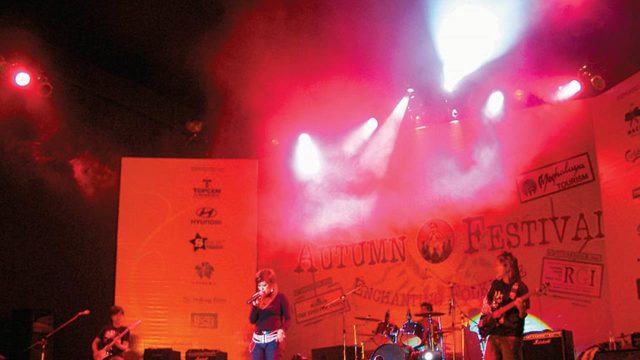Big mama Hornbill — Nagaland’s much-feted ‘Mardi Gras’ — may have long flitted away with the first prize. But Shillong’s Autumn Festival is ready to ruffle her feathers. And judging by the traffic on the wiry hill roads that led to the finale at Umiam lake (November 7-8), the weeklong fest — barely in its fourth year — had already arrived, full throttle.
I pulled in too. And so did all of Shillong. Toddlers in their Sunday best, kwai-chewing matrons, young mothers with mewling infants strapped over their jainsems (traditional Khasi drapes pinned on either shoulder), nine-to-fivers in pinstripes, seasoned archers with hand-crafted arrows and puffing pipes, and the ever-swelling Bob Dylan and Ozzy Osbourne flock, all gelled hair and biker boots. Yet walking down from the car park at noon, the fest — well-scrubbed and sweetened — appeared to be abigfatmuddle at first. Another doppelganger in the growing tribe of tourist festivals — that mother of all marketing ploys to reroute planeloads of travellers from the Goas, Keralas, Rajasthans. A crash-course for the lazy tourist and a merry fete for the locals.
Fortunately though, by the time the sun turned in (hastily at five), I had switched gears. Happily fed — on a pork-only diet of Garo, Khasi, Jaintia and Mizo food, with all ruddy thoughts of swine flu on the roast — and thoroughly plastered…no bootlegging this, but an oversize, warm Shillong ‘speak-easy’, where even the master of ceremony blarneyed the crowd to pick up a tipple and defy the November chill. In those liquid mo-ments, it was a minor miracle that the idea of paddling through the glacial waters of Umiam to my room at Ri Kynjai on the opposite bank, didn’t cross my foggy mind. Swayed by lethal quantities of bitchi (Garo rice beer), chhang-koe (Tibetan rice beer), and local fruit and berry wines crudely sealed with foil, it almost seemed unfair that drunken brawls and fistfights were not part of the entertainment.
What was part of the entertainment though, was a carte du jour of hearty harvest dances — occasionally with a preamble of rituals and incantations, and rarely ever too intricate — from all over the Northeast as well as Tibet, Bhutan and Bengal. Each jostling for attention with paintball and teer contests, hot-air ballooning, elephant rides, boat races, fashion shows and mock-flying fox drills (for kids)…even as the gentle duitara (stringed instrument) and nakra (drum) recitals at dusk, serenaded full-throated rock concerts with candy-coloured lasers and smoke machines.
But as with the young dancers whose traditional woven skirts and feathered headgear sat equally at ease with printed tees and fu-chsia kitten heels, this cobbling together of cultures and timelines didn’t lay bare any visible sutures. Nor did the vocalist of an all-girls’ rock band, flaunting an elaborate tribal cummerbund, or the i-Phone-hugging gambler, hazarding a guess at how many arrows jab the target, shy away from the stereotypes that the Northeast finds itself saddled with… And yet they turned every paradox on its head; perhaps, even more unflappably than the Lajpat Nagar housewife in her sequined salwar kameez and prized pair of Nikes.
With the babus now aboard the brand new flights launched by the old Maharaja — fuel-led by the Centre’s policy to allow its employees air travel if they are heading Northeast — Autumn Festival is likely to be bigger and better next year. Glad tidings for the LTC-clutching masses from South Block (Delhi) or downtown Chowringhee (Kolkata), whose travel advisory, I’d imagine, would read: Merry, merry, quite contrary.
Every year the fest is held in end October, spilling into the first week of November (see www.mtdf.co.in); entry fee is Rs 40. Stay options include Ri Kynjai (www.rikynjai.com).




